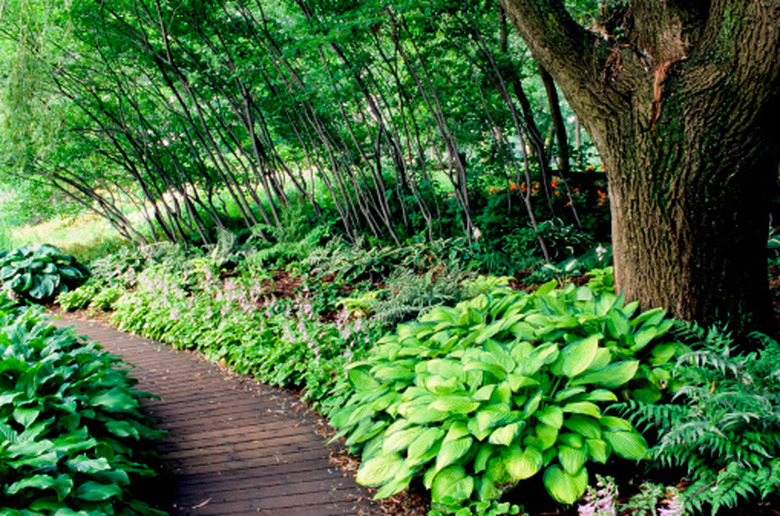How To Plant Hostas Under Trees
Hostas are shade-loving leafy perennial plants that are grown for their varied and vibrant foliage. Plants average 1 to 2 1/2 feet tall but some large varieties grow up to 4 feet tall and some miniatures remain only 3 to 4 inches tall for the duration of their life. Hostas thrive under threes and shrubs, where they get some morning and evening light but are shaded for most of the day. For a deeply shaded areas, select hostas that have blue tinges leaves. Other varieties that have yellow or gold leaves are less shade tolerant.
Step 1
Spread a 6-inch layer of compost or manure over the soil at the planting area. Work the soil into the top 6 inches of soil. Dig carefully with a hand trowel to avoid damaging larger tree roots.
- Hostas are shade-loving leafy perennial plants that are grown for their varied and vibrant foliage.
Step 2
Dig a hole in the center of the planting area slightly larger than the nursery pot. Slide the hostas out of the pots and place them in the planting holes. Space multiple plants 1 to 3 feet apart to give them room to grow and fill out. Plant dwarf varieties 1/2 a foot to 1 foot apart.
Step 3
Fill in the soil around the roots and press down the area with the flat of your hands. Soak the area until the soil around the planting hole is damp. Spread a 1- to 2-inch layer of organic material as a mulch layer over the planting area.
- Dig a hole in the center of the planting area slightly larger than the nursery pot.
- Space multiple plants 1 to 3 feet apart to give them room to grow and fill out.
Step 4
Apply 1 inch of water per week during the growing season. During rainy weather, reduce water applications in accordance with the rainfall.
Plant Hostas?
Hostas are popular perennials typically planted or transplanted in early spring and early fall. Gardeners have roughly 2,500 hosta varieties from which to choose, with each variety offering a wide array of leaf sizes, shapes, colors and textures. Place plastic pots over emerging plants if temperatures are going below freezing. In full afternoon sunlight, hostas can find themselves with leaf burn during summer. Hostas with blue leaves grow best in shade, and those with white, gold or yellow leaves prefer more sun exposure. The optimal pH level for hostas is 6.5 to 7.5. Dig a 12-inch-deep planting hole for each hosta plant. Tap around all sides of the container holding a hosta to loosen the soil and roots before removing the plant. Fill the hole with soil and water. These leaves take several weeks to open. At the completion of this leaf phase, the plants start producing white roots above roots they produced the previous year. Keep the plants well-watered because the leaves consist mostly of water. Hostas bloom for about three or more weeks in summer. Each lily-like blossom opens at the top of a long, vertical shoot. Apply a 2- to 3-inch-thick layer of mulch over the soil of hostas you planted or transplanted in spring or fall to protect the plants during winter. During winter, hostas remain dormant, with no growth of any kind.
- Apply 1 inch of water per week during the growing season.
- Apply a 2- to 3-inch-thick layer of mulch over the soil of hostas you planted or transplanted in spring or fall to protect the plants during winter.
Things Needed
- Shovel
- Compost or manure
- Trowel
References
- Ohio State University Extension Fact Sheet: Growing Hostas
- Clemson University Cooperative Extension: Hostas
- University of Minnesota: Planting Under Existing Trees
- Bellarmine University: Hosta
- American Hosta Society: The Hosta Gardening Calendar
- University of Vermont Extension: Choosing and Growing Hostas
- American Hosta Society: Establishing Hostas
